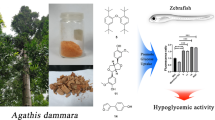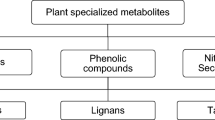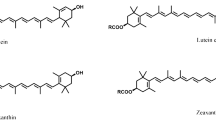Abstract
Suspension cultured cells of Caragana chamlagu (Leguminosae) converted zerumbone (1) into zerumbone epoxide (2) as the intermediate, (2R,3R,7R)-2,3-epoxy-9-humulen-8-one (3) and (2R,3S,7R)-2,3-epoxy-9-humulen-8-one (4) as new sesquiterpenes in 11%, 36% and 21% yields, respectively.
Similar content being viewed by others
Introduction
Many studies have been reported on the specific oxidation and reduction of olefins and alicyclic hydrocarbons with chemical reagents (Mukaiyama et al. 1993; Sharpless et al. 1992; Sakamaki et al. 1988).
From the viewpoint of “green chemistry”, biocatalysts have been used for the transformation of natural or artificial substrates into useful compounds (Flitsch et al. 2002). We have developed particularly the use of plant cultured cells for the biotransformation of natural products such as thujopsene (Sakamaki et al. 2001), ionone (Sakamaki et al. 2004) and valencene (Sakamaki et al. 2005) and unnatural substrates such as 1,2-diketone (Chai et al. 2003a), bisphenol-A (Chai et al. 2003b) and 3-acetylisoxazoles (Itoh et al. 2005).
Zerumbone (1; Fig. 2) is a novel humulenoid sesquiterpene having a flexible skeleton structure and was prepared from wild ginger (Zingiber zerumbet Smith) by hydrodistillation (Dev 1960). Recently, the bioactivity of 1 and its derivatives has been reported to include the anti-inflammatory and anti-tumor-promoting activity (Liao et al. 1999; Murakami et al. 1999).
Herein, in order to investigate the flexibility of ring for sesquiterpene, we studied the biotransformation of 1 by the suspension of Caragana chamlagu.
Materials and methods
Analytical and substrates
Melting points were determined on a Shimadzu micro melting point apparatus. IR spectra were recorded using a Hitachi 270-50 and a Jasco FT-IR 230 spectrophotometer. Optical rotation was determined using a Horiba SEPA-200 polarimeter. 1H and 13C NMR spectra were recorded at 400 MHz using a JEOL GX-400 spectrometer with SiMe4 as the internal reference. High resolution mass spectra (HREIMS) were obtained on a Hitachi M-80B spectrometer. GC-MS were recorded a Shimadzu GC-MS QP5050 (EI-MS) 70 eV using DVI (0.25 mm × 30 m, 0.25 μm) capillary column. GC was performed using a 2% (w/v) OV-17 column (5 mm × 3 m) at 200°C and Chiral GC-column (CP-cyclodextrin-B-2,3,6-M-19[CPCD], 25 m attached to a Shimadzu GC-17A).
Cultivation of suspension cells
Cells of Caragana chamlagu were obtained by surface sterilization of leaves for 30 s in 70% (v/v) ethanol, followed by washing twice with sterile distilled water and then transferring to agar Murashige and Skoog medium. The cultured cells from leaves of C. chamlagu have been maintained our laboratory for more than 10 years.
Prior to use for biotransformation experiments, the cultured cells were transplanted to a 300 ml flask containing 100 ml MS medium with 3% (w/v) sucrose, 1 ppm of 2,4-dichlorophenoxyacetic acid (2,4-D), and cultured on an orbital shaker (120 rpm) for 3 days at 25°C in the dark.
Biotransformation of 1 by C. chamlagu
To the flask containing the suspended cells (dry wt. 0.2 g) of C. chamlagu in MS medium (100 ml), zerumbone (1, 90 mg) in dimethyl sulfoxide (DMSO) (1 ml) was added. Cultures were incubated at 25°C on an orbital shaker (120 rpm) for 10 days in the dark and then cells and medium were separated by filtration with suction. The filtered culture medium was extracted with ethyl acetate, the solvent dried over anhydrous Na2SO4, and removed in vacuo. The residue (83 mg) was chromatographed on silica gel (SiO2), using benzene/ethyl acetate (10:1 v/v) to give (2R,3R,7R)-2,3-epoxy-9-humulen-8-one (3, 36% by GC). Elution with benzene/ethyl acetate (5:1 v/v) afforded (2R,3S,7R)-2,3-epoxy-9-humulen-8-one (4, 21% by GC). Elution with benzene/ethyl acetate (5:1 v/v) gave zerumbone epoxide (2, 11% by GC).
Biotransformation of 2 by C. chamlagu
Zerumbon epoxide (2, 20 mg) in DMSO (0.2 ml) was added to the flask containing suspended cells (dry weight 0.1 g) of C. chamlagu in MS medium (40 ml), and the cultures were incubated at 25°C on an orbital shaker (120 rpm) for 7 days in the dark. Cells and medium were then separated by filtration. Metabolites (16 mg) were extracted as above and the conversion yields of 3 (46% yield), and 4 (37% yield) were determined on the basis of the peak ratio in the GC analysis of the ethyl acetate extract. Enantiomeric excess (ee) and yields for 3 (98% ee (R)), 4 (95% ee (R)) were determined by chiral GC analysis.
Time course experiments
Cultured cells of C. chamlagu (dry wt. 0.2 g) was transferred to several 300 ml Erlenmeyer flask containing 100 ml MS culture medium and each substrates (90 mg) was added to the suspension culture and incubated at 25°C in a rotary shaker (120 rpm) in the dark. At intervals, several flasks were taken out and filtered. The filtrate extracted with ethyl acetate. The conversion yields of the products were determined on the basis of the peak ratio in the GC analysis of the ethyl acetate extract.
Synthesis of 2 by m-chloroperbenzoic acid
Zerumbone (1, 54 mg) in dry dichloromethane (CH2Cl2) (10 ml) was added to m-chloroperbenzoic acid (50 mg) in dry CH2Cl2 (10 ml) and the mixture was stirred at room temperature for 3 h. After reaction ceased, 1 M NaOH was added and the products were extracted with CH2Cl2. After washing with water, the organic layer was dried over Na2SO4 and the solvent was removed in vacuo. The crude product was chromatographed on SiO2, using benzene/ethyl acetate (5:1 v/v) as eluent to give zerumbone epoxide (2, 38 mg).
Spectral data of compounds
Zerumbone epoxide (2): mp. 94–96°C; [α]D: 0° (c 0.45, CHCl3); IR (CHCl3): νmax 1660, 1620 cm−1, 1H NMR (CDCl3): δ 1.09 (3H, s, H-15), 1.23 (3H, s, H-14), 1.30 (3H, s, H-12), 1.86 (3H, s, H-12), 6.09 (1H, br.d, J = 9 Hz, H-6), 6.11 (2H, d, J = 1.7 Hz H-9,10), 1.30 (3H, s, H-12); 13C NMR (CDCl3): 202.6 (s, C-8), 159.2 (d, C-10), 147.5 (d, C-6), 139.4 (s, C-7), 128.2 (d, C-9), 62.6 (d, C-2), 61.2 (s, C-3), 42.4 (t, C-1), 38.2 (t, C-4), 35.9 (s, C-11), 29.8 (q, C-15), 24.6 (t, C-5), 23.5 (q, C-14), 15.6 (q, C-12), 12.0 (q, C-13); HREIMS m/z: 234.1618 (calcd for C15H22O2, 234.1619).
(2R,3R,7R)-2,3-Epoxy-9-humulen-8-one (3): mp. 82–84°C; [α]D: −9° (c 0.67, CHCl3); 98% ee (R); IR (CHCl3): νmax 1691, 1631 cm−1; 1H NMR (CDCl3): δ 1.02 (3H, s, H-13), 1.15 (6H, s, H-14,15), 1.28 (3H, s, H-12), 2.71 (1H, t, J = 2,11 Hz, H-7), 2.73 (1H, t, J = 2,11 Hz, H-2), 6.33 (1H, d, J = 19 Hz H-9), 6.38 (1H, d, J = 19 Hz, H-10); 13C NMR (CDCl3): δ 204.8 (s, C-8), 149.6 (d, C-10), 128.0 (d, C-9), 61.8 (s, C-3), 60.6 (d, C-2), 45.4 (d, C-7), 40.4 (t, C-1), 38.7 (t, C-4), 36.1 (s, C-11), 33.3 (t, C-5), 29.8 (q, C-15), 23.5 (q, C-14), 18.0 (t, C-6), 17.2 (q, C-12), 11.9 (q, C-13); HREIMS m/z: 236.1777 (calcd for C15H24O2, 236.1776).
(2R,3S,7R)-2,3-Epoxy-9-humulen-8-one (4): white, amorphous solid; [α]D: +7° (c 0.67, CHCl3); 95% ee (R); IR (CHCl3): νmax 1691, 1631 cm−1; 1H NMR (CDCl3): δ 1.01 (3H, s, H-13), 1.02 (3H, s, H-15), 1.16 (3H, s, H-14), 1.18 (3H, s, H-12), 2.72 (1H, t, J = 2,11 Hz, H-7), 2.73 (1H, t, J = 2,11 Hz, H-2), 6.33 (1H, d, J = 19 Hz, H-9), 6.38 (1H, d, J = 19 Hz, H-10); 13C NMR (CDCl3): δ 206.7 (s, C-8), 151.5 (d, C-10), 124.7 (d, C-9), 61.9 (s, C-3), 60.8 (d, C-2), 48.1 (d, C-7), 40.2 (t, C-1), 39.1 (t, C-4), 36.2 (s, C-11), 35.8 (t, C-5), 29.8 (q, C-15), 23.6 (q, C-14), 21.4 (t, C-6), 16.8 (q, C-12), 11.9 (q, C-13); HREIMS m/z: 236.1774 (calcd for C15H24O2, 236.1775).
Results and discussion
The results of this biotransformation are shown in Figs. 1 and 2. The incubation of 1 with the suspension cultures of C. chamlagu for 10 days gave 2 in a 11% yield, 3 in a 36% yield and 4 in a 21% yield. The spectral data on 2 agreed with those on the zerumbone epoxide synthesized from 1 (Matthes et al. 1982).
Time course for biotransformation of zerumbone by Caragana chamlagu. Reaction conditions: zerumbone 1 (90 mg); plant cultured cells (0.2 g dry wt.); MS liquid medium (100 ml); shaking 120 rpm at 25°C in the dark. Reaction products: zerumbone epoxide 2; (2R,3R,7R)-2,3-epoxy-9-humulen-8-one 3; (2R,3S,7R)-2,3-epoxy-9-humulen-8-one 4
The products 3 and 4 were obtained as crystal and amorphous. They showed the same molecular formula of C15H24O2, and their IR spectra displayed absorptions corresponding to those of carbonyl groups (1691 cm−1) and double bond (1631 cm−1). Their 1H NMR spectra were very similar and showed the presence of trans-olefin proton signals at δ 6.33 (d, J = 19 Hz, H-9) and δ 6.38 (d, J = 19 Hz, H-10), one oxygen substituted methine proton signal at δ 2.73 (1H, J = 2, 11 Hz, CH–O) and four methyl proton signals, while their 13C NMR spectra showed three methyl signals, one secondary methyl signals, three quaternary carbon signals, four methylene signals and four methine carbon signals. The HMBC spectra of 3 and 4 showed a C–H correlation between the signal of a methyl proton at C-12 and those at C-2, C-4 and C-13, and between the signal of a methyl proton at C-13 and those at C-6 and C-8. The relative stereochemistry of 3 and 4 was assigned from the difference nuclear Overhauser effects (NOEs) experiment on new sesquiterpenes (Usia et al. 2004). In the case of 3, NOEs were observed from H3-14 to H-2 and H-9, from H3-15 to 10-H and from H3-12 to 10-H and H3-13, while in the case of 4, NOEs were observed from H3-14 to H-9 and H-2 and from H3-12 to H-2. Thus, compounds 3 and 4 have the conformation as shown in Fig. 3. Furthermore, we confirmed that the incubation of 2 with the cultured cells of C. chamlagu afforded 3 (46% yield) and 4 (37% yield), respectively.
Based on these spectral data and asymmetric reduction, compounds 3 and 4 were determined to be (2R,3R,7R)-2,3-epoxy-9-humulen-8-one and (2R,3S,7R)-2,3-epoxy-9-humulen-8-one, respectively.
From these results, zerumbone 1 possessing flexible ring is preferentially biotransformed to epoxy derivatives in comparison with allylic oxidation of thujopsene and valencene having rigid rings. Especially, the epoxidation of 1 by cultured cells of C. chamlagu was not stereoselective, while the asymmetric reduction of 2 by cultured cells of C. chamlagu was highly enantioselective. The suggested metabolic pathway for biotransformation of 1 by the cultured cells of C. chamlagu therefore proceeds through an epoxidation of the double bond in 1 and then the asymmetric reduction of 2 as intermediate gives 3 and 4.
References
Chai W, Sakamaki H, Kitanaka S, Horiuchi CA (2003a) Biotransformation of cycloalkanediones by Caragana chamlagu. Bull Chem Soc Jpn 76:177–182
Chai W, Sakamaki H, Kitanaka S, Saito M, Horiuchi CA (2003b) Biodegradation of bisphenol A by cultured cells of Caragana chamlagu. Biosci Biotechnol Biochem 67:218–220
Dev S (1960) Zerumbone, a monocyclic sesquiterpene ketone. Tetrahedron 8:171–180
Flitsch S, Gideon G, Ashcroft D (2002) Oxygenation of C–H and C=C bonds. In: Drauz K, Waldman H (eds) Enzyme catalysis in organic synthesis, vol III, 2nd edn. Wiley-VHC Verlag GmbH, Weinheim, pp 1065–1108
Itoh K, Sakamaki H, Nakamura K, Horiuchi CA (2005) Biocatalytic asymmetric reduction of 3-acetylisoxazoles. Tetrahedron Asymmetry 16:1403–1408
Liao Y-H, Houghton PJ, Hoult JRS (1999) Novel and known constituents from Buddleja species and their activity against leukocyte eicosanoid generation. J Nat Prod 62:1241–1245
Matthes HWD, Luu B, Ourisson G (1982) Transannular cyclization of zerumbone epoxide. Tetrahedron 38:3129–3135
Mukaiyama T, Yamada T, Nagata T, Imagawa K (1993) Asymmetric aerobic epoxidation of unfunctionalized olefins catalyzed by optically active α-ketoiminato manganese(III) complexes. Chem Lett 22:327–330
Murakami A, Takahashi M, Jiwajinda S, Koshimizu K, Ohigashi H (1999) Identification of zerumbone in Zingiber zerumbet Smith as a potent inhibitor of 12-O-tetradecanoylphorbol-13-acetate-induced Epsein–Barr virus activation. Biosci Biotech Biochem 63:1811–1812
Sakamaki H, Take M, Matsumoto T, Iwadare T, Ichinohe Y (1988) Transformation of cycloartanyl acetate into B-homo triterpenoids. J Org Chem 53:2622–2624
Sakamaki H, Kitanaka S, Chai W, Hayashida Y, Takagi Y, Horiuchi CA (2001) Biotransformation of thujopsene by Caragana chamlagu. J Nat Prod 64:630–631
Sakamaki H, Itoh K, Chai W, Hayashida Y, Kitanaka S, Horiuchi CA (2004) Biotransformation of (±)-α-ionone and β-ionone by cultured cells of Caragana chamlagu. J Mol Catal B Enzym 27:177–181
Sakamaki H, Itoh K, Taniai T, Kitanaka S, Takagi Y, Chai W, Horiuchi CA (2005) Biotransformation of valencene by cultured cells of Gynostemma pentaphyllum. J Mol Catal B Enzym 32:103–106
Sharpless KB, Amberg W, Bennani Y, Crispino G, Hartung J, Jeong K, Kwong H, Morikawa K, Wang Z, Xu D, Zhang X (1992) The osmium-catalyzed asymmetric dihydroxylation: a new ligand class and a process improvement. J Org Chem 57:2768–2771
Usia T, Iwata H, Hiratsuka A, Watabe T, Kadota S, Tezuka Y (2004) Sesquiterpenes and flavonol glycosides from Zingiber aromaticum and their CYP3A4 and CYP2D6 inhibitory activities. J Nat Prod 67:1079–1083
Acknowledgments
This work was partially supported by a special research Grant-in-Aid for the promotion and mutual aid corporation for private school of Japan to Nihon University.
Author information
Authors and Affiliations
Corresponding author
Rights and permissions
About this article
Cite this article
Sakamaki, H., Itoh, Ki., Kitanaka, S. et al. Biotransformation of zerumbone by Caragana chamlagu . Biotechnol Lett 30, 2025–2029 (2008). https://doi.org/10.1007/s10529-008-9783-5
Received:
Revised:
Accepted:
Published:
Issue Date:
DOI: https://doi.org/10.1007/s10529-008-9783-5







